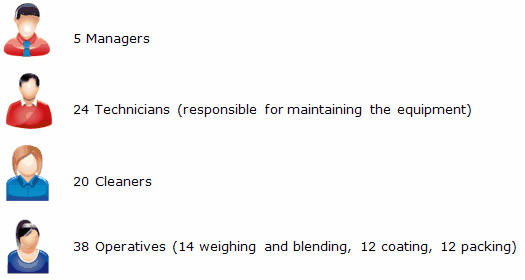How many samples?
Exposure groups
If there are only a few workers exposed to a contaminant, it should be feasible to sample them all.
However, with larger groups of workers, this can be impractical due to the time and costs involved.
In these cases the best way to proceed is to:
- Divide the workers into groups who are likely to have similar exposures (sometimes referred to as "similar exposure groups" or SEGs)
- Decide which of these groups are likely to have the highest exposures
- Select a number of workers from each group for sampling.
A good starting point is to look at job titles and descriptions. However, sometimes people with the same job description can carry out quite different tasks, have different exposure patterns, etc.
So, groups based on job titles sometimes need to be further sub-divided. The information you collected during your initial evaluation will normally help you to do this.
How many samples?
US guidance suggests 6 to 10 measurements from each similar exposure group are normally enough to obtain a reasonable estimate of worker exposures.
In the UK, it is suggested that:
- 1 sample should be collected for every 5 workers in an exposure group for "worst case" sampling (~20%), and
- At least 5 samples collected from exposure groups with a maximum of 10 workers for "representative" sampling (~50%).
However, common sense needs to be used - balancing the value of the results against the cost of the survey.
Determining exposure groupings
Let’s take the example of a pharmaceutical manufacturing department where there are:

It is obvious that these different groups will have quite different exposure patterns:
- Managers have little chance of being exposed to significant concentrations so it is probably not worth carrying out sampling to assess their exposure
- Operatives probably handle the substances on and off throughout the day
- Cleaners and technicians are likely to have quite high exposures on occasions, but may have long periods during the day where their exposure is minimal.
Having decided on which groups to sample, it is worth taking a closer look to see whether they need to be sub-divided.
For example, our 38 operatives work on three different processes. The weighing/blending and coating processes are likely to present a risk of significant dust exposure because the workers are handling powdered materials. However, if coated tablets are being packed, those operating the packing machines probably have little dust exposure.
If we are targeting the high-risk groups then we may want to exclude the workers on the packing process.
Determining how many from each group
Let’s have another look at our pharmaceutical manufacturing department. We have already decided that it is not worth carrying out sampling for the managers and the operatives on the packing lines, so we are now left with:
- 24 technicians
- 20 cleaners
- 14 operatives (weighing and blending)
- 12 operatives (coating process)
Remember that guidance suggests we sample approximately 20% (for worst case) and approximately 50% (for representative sampling).
If we followed the guidance for representative sampling, how many samples should we collect from the group of cleaners?
We would need approixmately 10 samples.
If we were using a worst-case sampling strategy, how many samples should we collect from the group of technicians?
We would need to collect samples from at least 1 out of every 5 workers in the population, so about 5 or 6.
